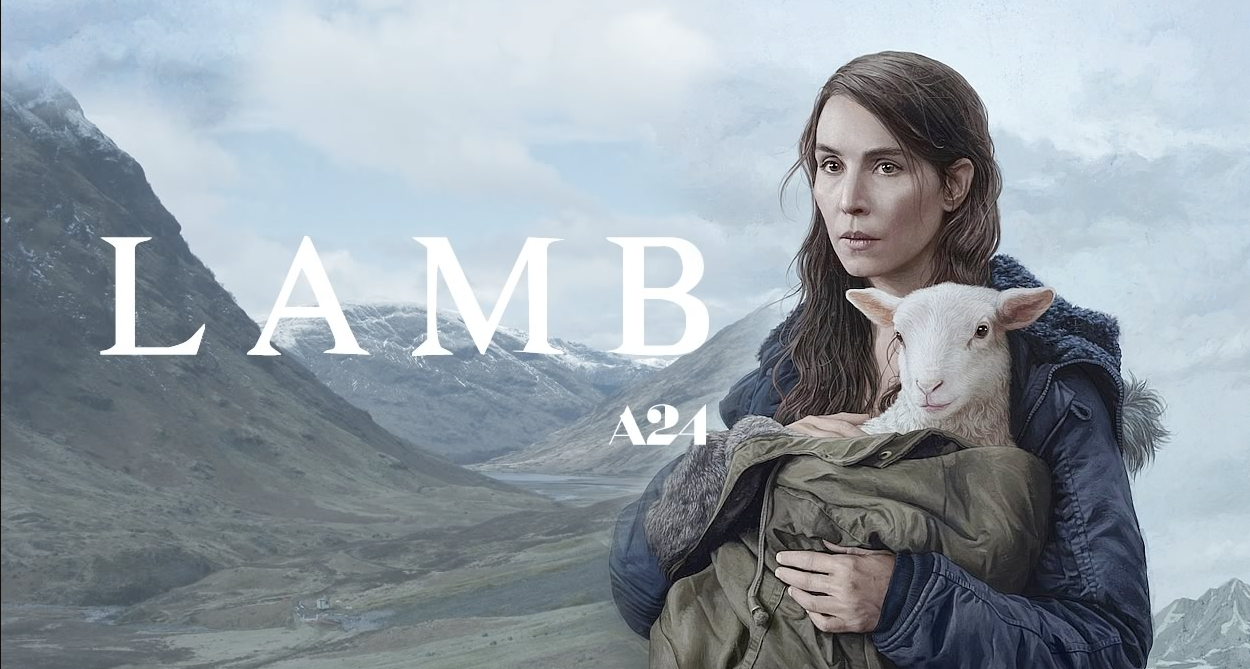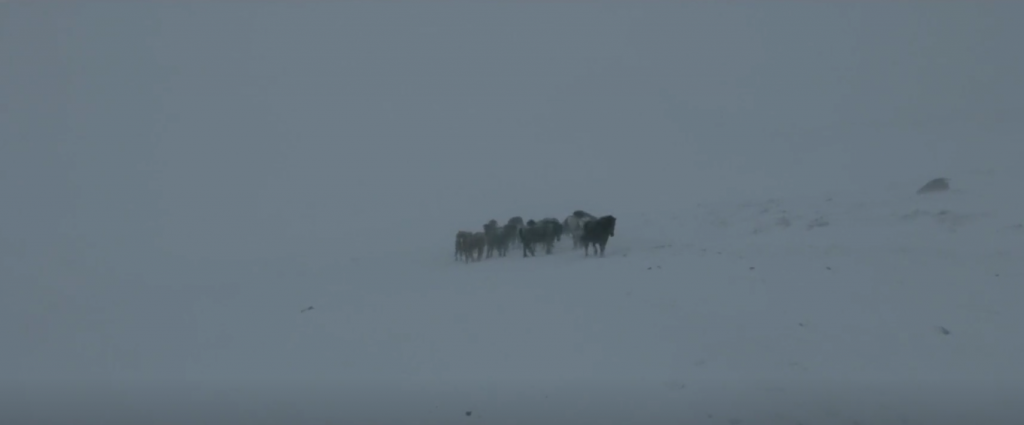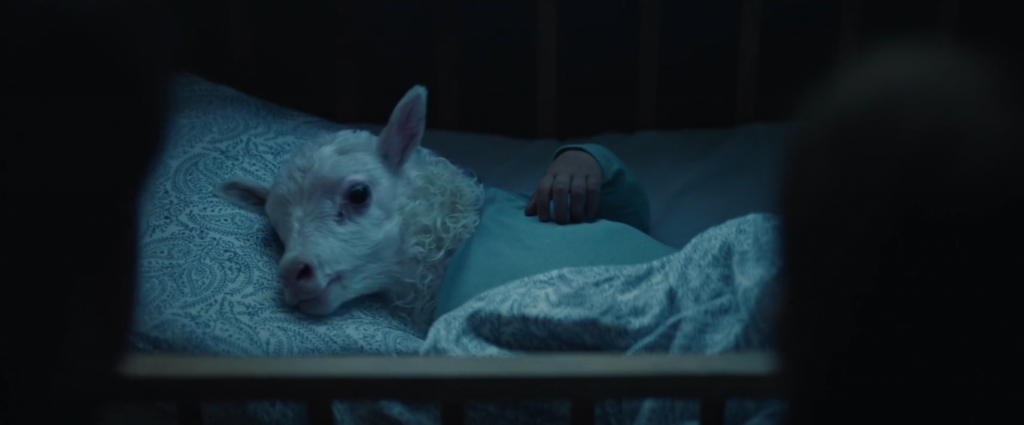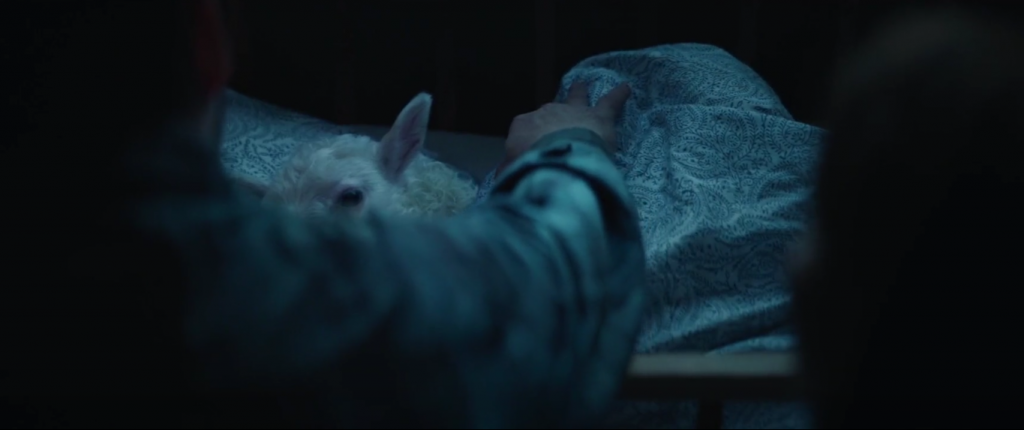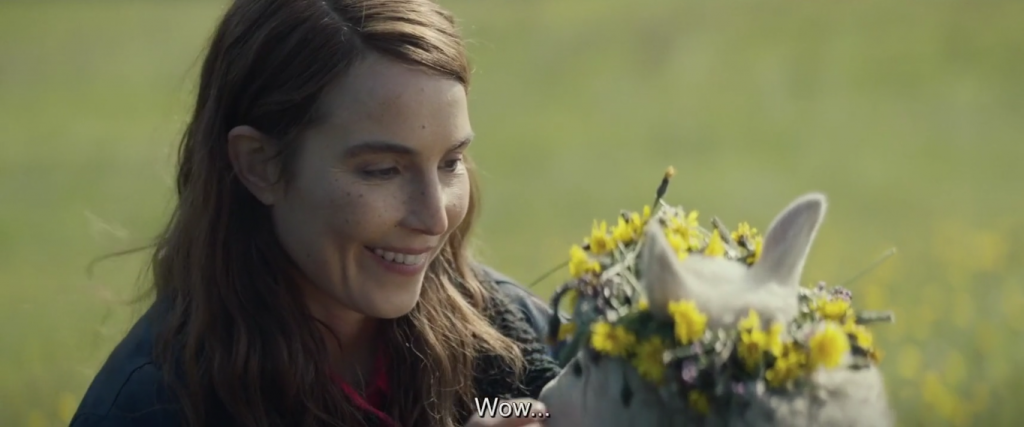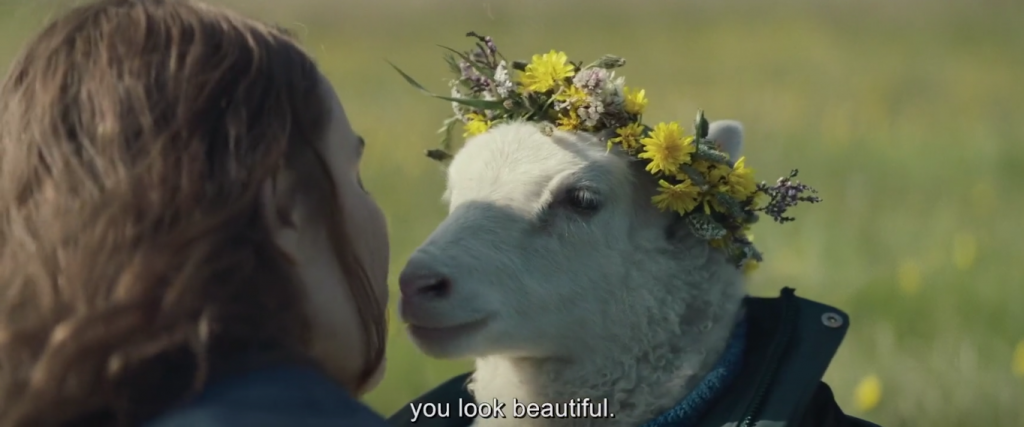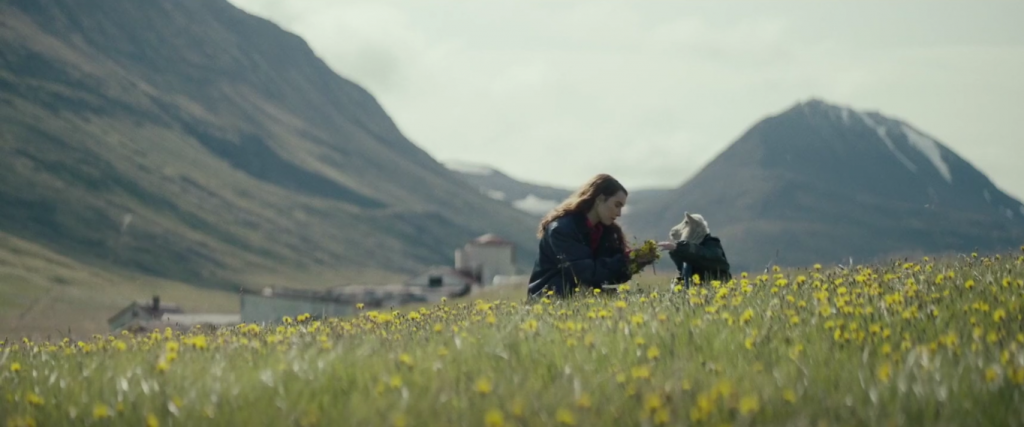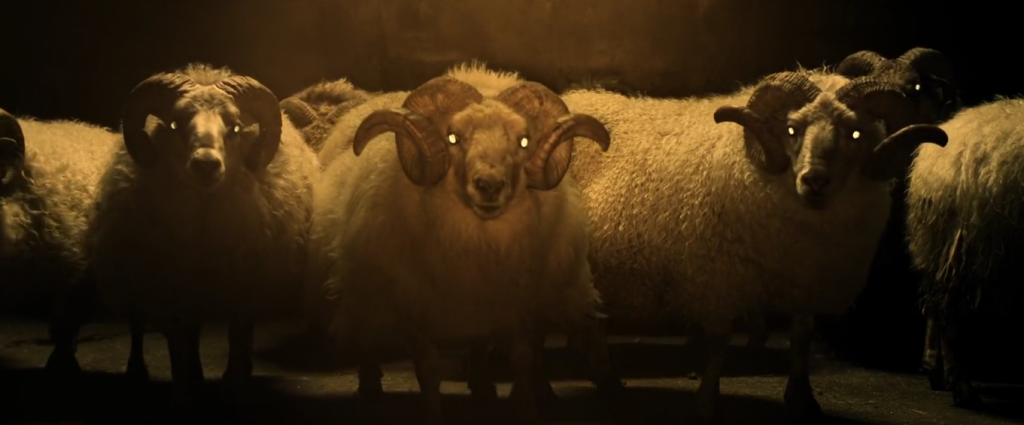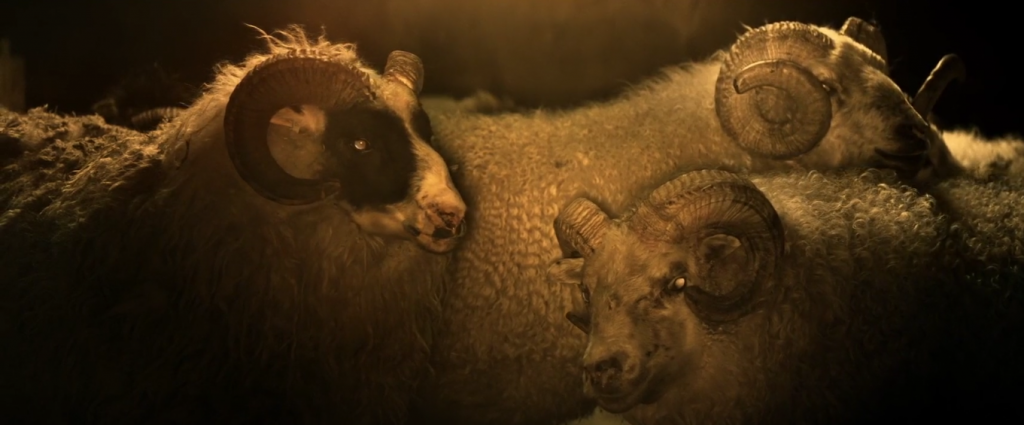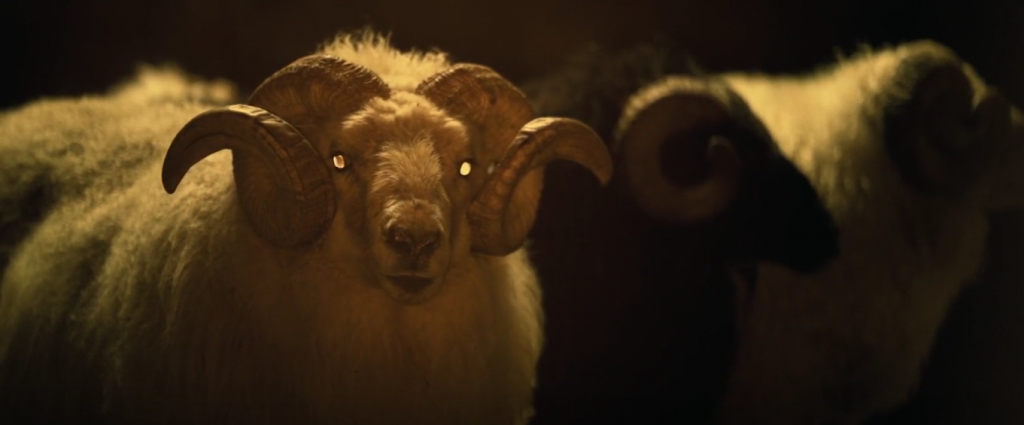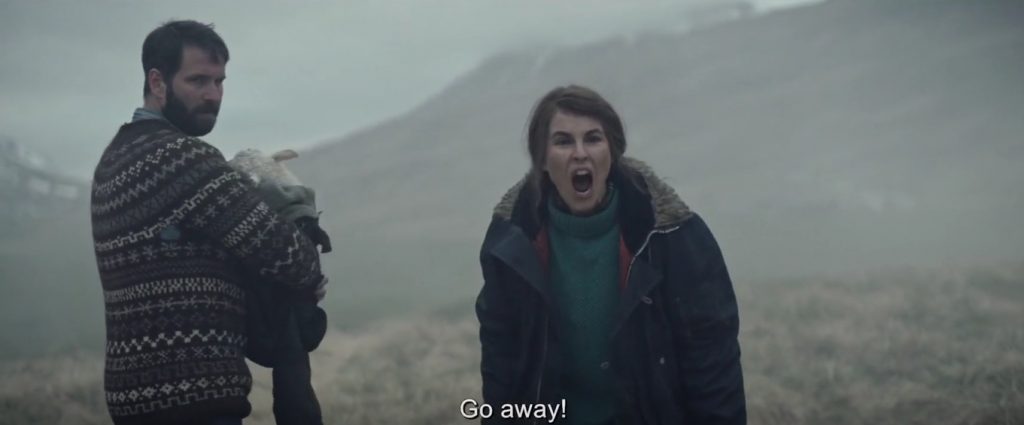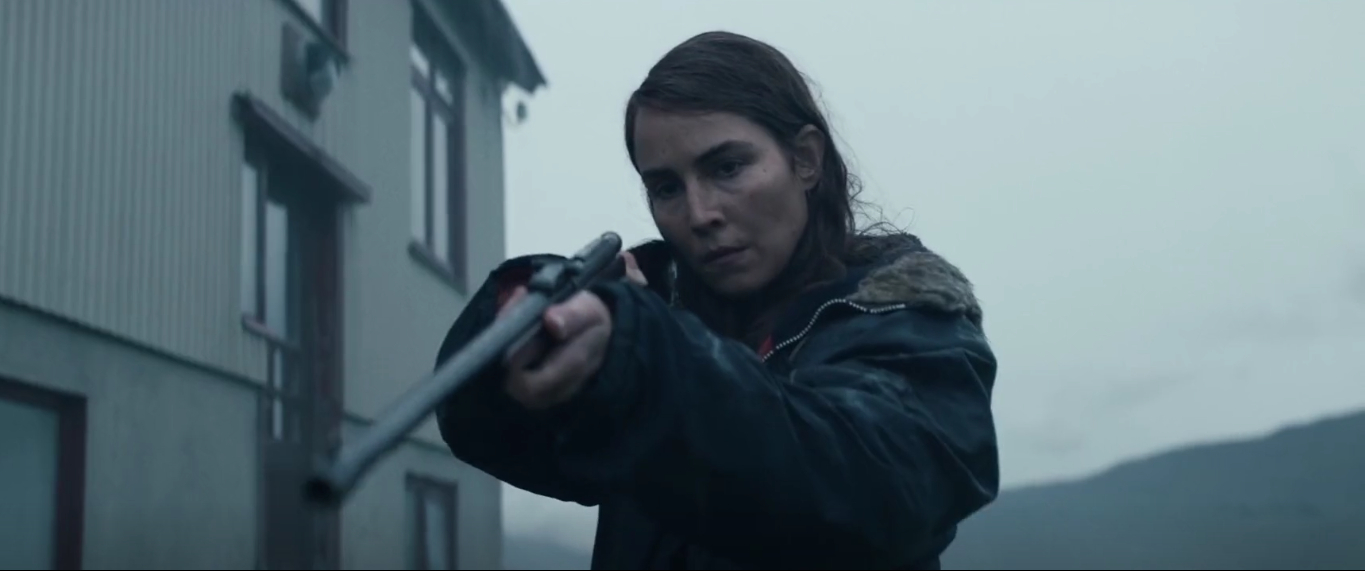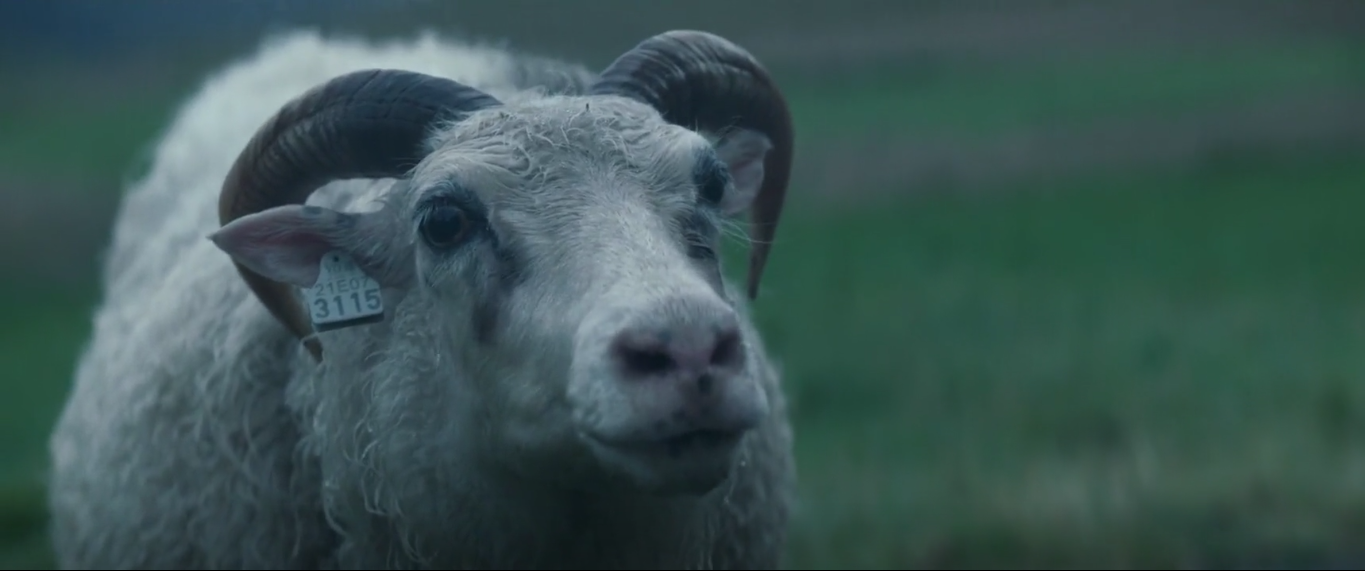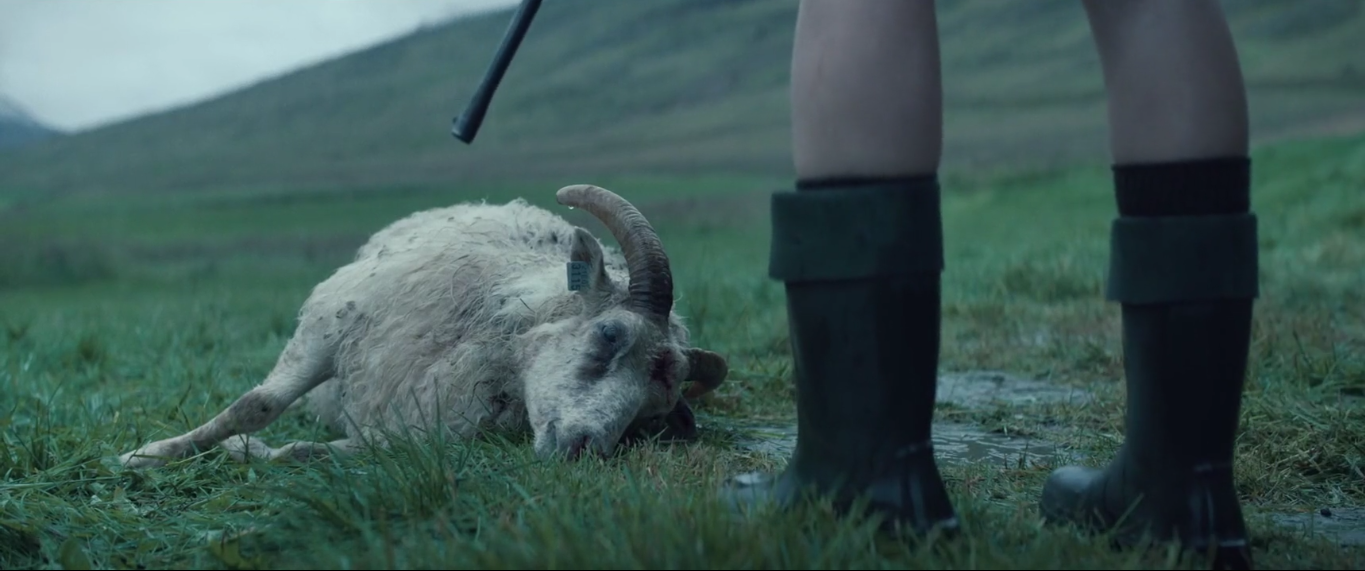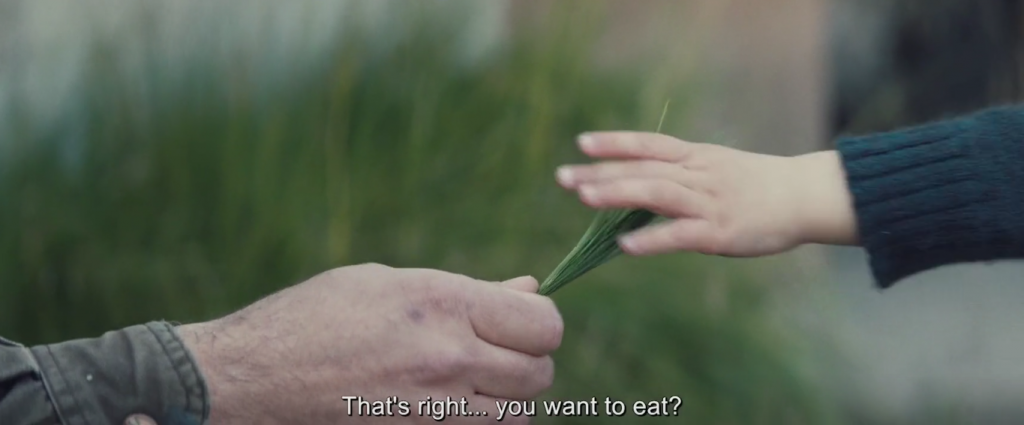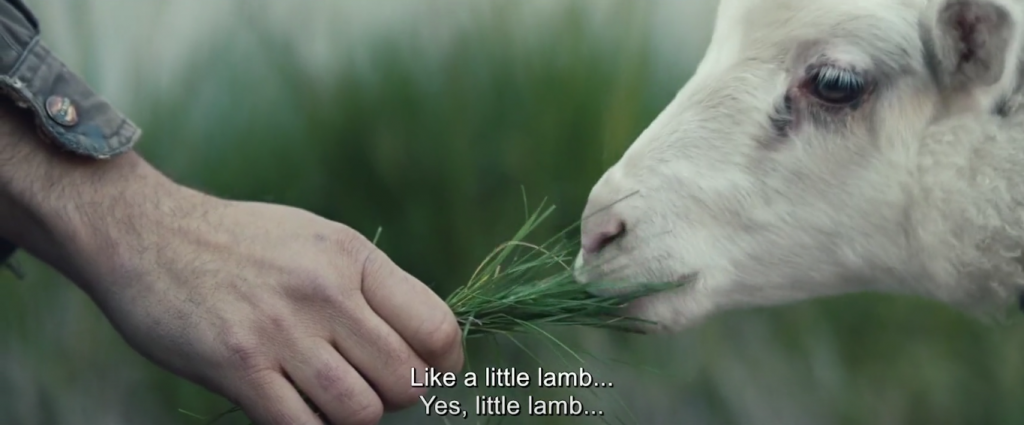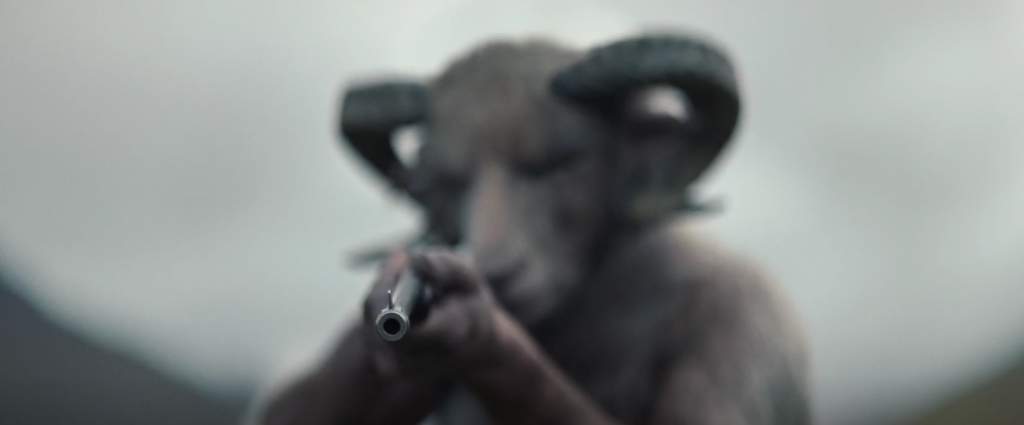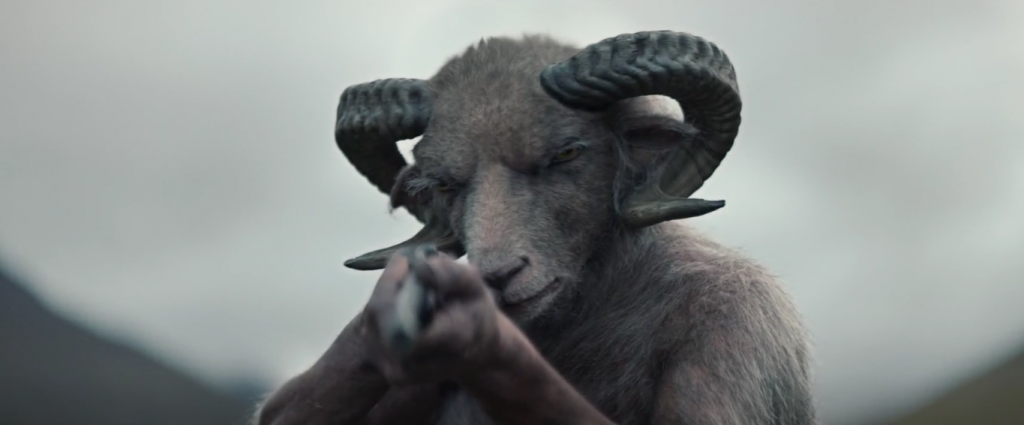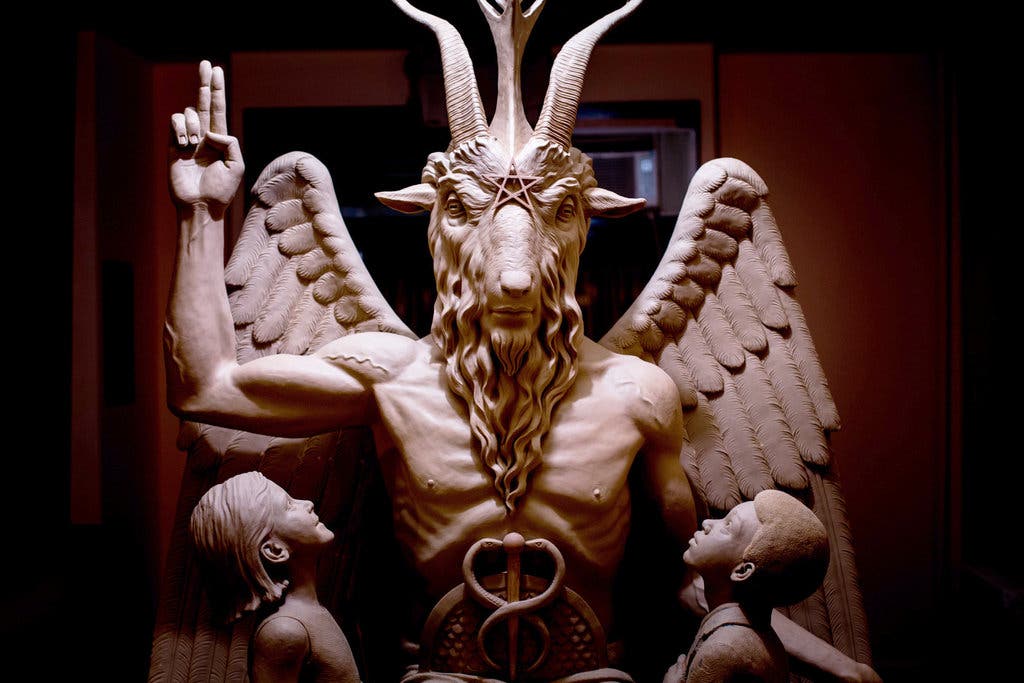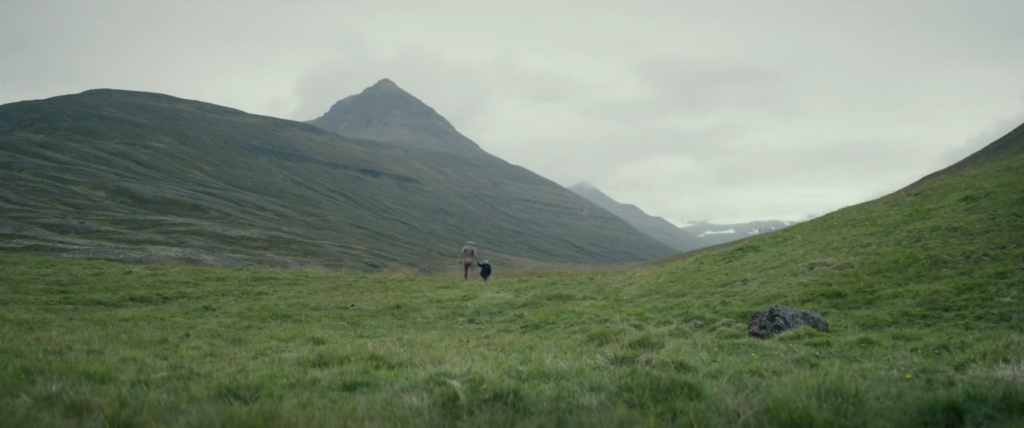Like a lamb to the slaughter, the slow-burn, absurd surrealness of A24’s Lamb (2021) leads the audience to an end that blends both chilling twists and heartbreaking loss as the complications that are inevitable with blurring binaries between human-animal relations come to fruition. In a playful, sardonic reconfiguration of oppositions between captivity and freedom, wildness and civilisation, human and animal, Lamb destabilises our understanding of the discourse of species as we are pushed to introspectively examine the innate narcissism inherent in human exceptionalist thinking. The hybrid nature of the anthropomorphic Ada transgresses boundaries of species as the characters and the audience grapple with navigating her miscellaneous identity as she straddles both human and animal spheres.
The representation of sheep in the film is unfixed, uneasily fluctuating as Ada disrupts the previously rigid distinctions between human and animal. These alienating boundaries lie parallel to the barren Icelandic landscape which provides a sublime backdrop for the gritty life of María and Ingvar, an isolated childless couple who wordlessly follow their monotonous daily routine. This subdued, domestic sphere is infused with a lackluster, despondent mood, reflected by the tepid colour palette of unsaturated pastel greys and blues that the film is washed with. The disconnect between humanity and nature is embodied by the separation of the couple from the (seemingly) docile sheep, as the physical realms of the house and the barn do not intermingle, a visual allusion to the ice distance of human-animal relations. However, the opening of the film foreshadows a revision of this twisted discourse of species as an unidentified entity appears to transgress the unvoiced boundary between human and animal, disturbing a herd of horses and essentially animality. In this scene, the point-of-view shot and the grunting sound effects amidst an eerie sea of fog signal a threatening force that will complicate the binary oppositions between human and animal, remaining a constant anxiety that underpins the film, quietly restraining itself to unleash in full force at the end.
This disruption of human-animal distinctions is embodied by the birth of Ada who engenders an entirely new representation of animality and wildness in the film. Although Ada is not revealed to be a hybrid immediately, her existence is clearly significant as she trespasses the physical boundary from the animal barn to the human house, instantly reconfiguring set boundaries between the couple and the sheep. Although a mixture of CGI and child actors morphed Ada’s existence, Noomi Rapace insists that she ‘was very much physically present’ [1], adding another dimension to the human-animal relations in the context of our world as we untangle the blurred boundaries between reality and technology. The complications inherent in Ada’s existence are never explicitly tackled in terms of Ada’s father and the uncomfortable implications of potential beastiality linger until the film’s twisted ending. Yet Ada’s hybrid nature is met with detached wonder and quiet acceptance, a perhaps perplexingly anticlimatic reaction, a stark contrast to the overwhelming shock or disgust the audience may have been expecting. However, there is something humanity finds moving in ‘the spontaneous touch of the other, the bridge between ‘animal’ and ‘man’ built by the animal as a spontaneous and meaningful gift’ [2], a blessing which María and Ingvar cherish. The affinity in this ‘touch across difference’ [3] asks the viewer to reconsider our myopic anthropocentric perceptions of different representations of animality. Lamb forces us to push our understanding of the ‘other’ to a more inclusive, accepting level as we grow to not only accept Ada but become entranced by her. Although the visual image of an amalgamation of lamb and child teeters on the edge of uncanniness as it transgresses normative physical human-animal distinctions, Ada is cleverly anthropomorphised into a lovable ‘humanised animal’ [4], finding her hooves in a humanised world.
The scene of Ada and María playing with flower crowns is particularly charming, the intimacy of the close-up shots allowing the audience to savour a rare moment of unbridled joy in the film. The natural sunlight and saturated colours break away from the gloomy, blue-tinged cast of the first chapter, evoking images reminiscent of nostalgic childhood memories. At first, we are perhaps startled to see Ada in an entirely human context, yet the harmless and mundane nature of the activities inspires affection as we view Ada as endearing and playful rather than abnormally threatening. However, the concept of hybridity becomes troubling as Ada is torn between the human and animal world, a discrepancy that fuels the ‘Madagascar problem’ that operates in the film. Her fluid identity simply cannot ‘accommodate what simplistically may be called recognisably true animal actions, behaviour and primal motivation’ [5]. The impossible logic of this odd cinematic universe could never work in a reality where laws and technology dominate our lives, leaving María and Ingavr doomed from the start as they cling to borrowed time with Ada.
This anxiety is particularly reflected by María as the presence of the sheep and their inherently wild animality begins to threaten the constructed reality she is desperate to maintain. In the nightmare scene, the hazy forms of rams with reflective eyes and flaring nostrils gradually come into harsh focus as an eerie ringing sound resonates in the background. Fiery artificial lighting juxtaposes the chilly pastels that consume the film, symbolic of how María’s relationship with the sheep has been irrevocably soured. The stark contrast between the harmless domesticity of the sheep and the malevolent nightmare rams represents how animality only mutates into something dangerous when it begins to impinge on human agency and power, a highly troubling byproduct of anthropocentric thinking and human exceptionalism.
The constant reminder that Ada is half sheep causes paralysing anxiety for the couple who become painfully aware of their lack of parental claim and desperately attempt to compress Ada’s animality. Resentment and insecurity bubble up in the childless couple who do not have the ability to easily procreate like the sheep and therefore find themselves in a vulnerable position of powerlessness that destabilises the discourse of species. Indeed, the couple would rather this feeling ‘go away’, a threat María screams at Ada’s mother, one of the only expressions of explosive, intensely angry dialogue in the film, and a disturbing twist on the comic trope of the ‘other woman’.
The acute anxiety felt by María as she rediscovers buried maternal instincts with Ada becomes especially poignant as we learn she previously lost a child, transforming Lamb into an analogy about motherhood. Her fierce protectiveness comes to a height when she feels the urge to curb the animality and wildness that threatens her idealistic vision of a strong, bonded family unit. The threat to this fantasy takes the form of the animal mother sheep, who demonstrates agency and maternal instincts that rival María’s as she attempts to reclaim her child, elevating an animal to the same emotional intelligence shown by humans. Maternal instinct is a trait that is valued by our own innate human exceptionalism and by blurring species binaries, the concept of absolute, radical difference between human and animal is stripped apart leaving two mothers fighting over a child. The spontaneous burst of rage and jealousy in the scene where María shoots Ada’s mother is reflected by her mismatched outfit, as this gunslinging, negligee-wearing farm girl turns feral in her determination to protect the bliss of new motherhood. The camera switches from close-up shots of María to Ada’s mother, who inquisitively gazes up at the gun, ‘ready to sound an alarm at the intrusion of man, but also ready to hold forever the gaze of meeting, the moment of truth, the original encounter’ [6]. This gaze between animal and human is severed after María shoots Ada’s mother, the ground-level shot of María’s boots standing over the sheep’s dead body a sharply astute visual microcosm of contemporary reality as hypermodern technology renders human-animal relations destructive.
The brutally unjustified shooting of the mother raises uncomfortable questions surrounding ‘biopolitics as a descriptor for human violence towards non human animals’ [7], exposing how humans threatened by animal agency will choose to eliminate threat to human exceptionalism rather than encourage harmony. When viewed from an ecocritical lens, the callous murder is especially troubling when examining human-animal relations as the sheep is Ada’s biological mother whose child has been stolen. It is particularly problematic that this unfair power dynamic only exists between humans and animals as in a human context, stealing someone else’s baby simply because you do not have your own is, unsurprisingly, illegal. The isolated, sublime landscape is stonily unaffected by the ethical, and moral questions that exist in our human reality as they are rendered unimportant by María and Ingvar who appoint themselves as Icelandic deities to justify their selfish agenda. This distinction raises important ontological questions surrounding empathy as it is problematic that María feels no guilt swiping Ada from a sheep, and the audience has to critically examine her apparent lack of moral compass. Would María hesitate if she was given the option to steal a baby from a protesting human woman? Most likely. However, human-animal relations are complicated further as although we are decisively uncomfortable with the murder, we can empathise with María as a childless mother. A human audience will unashamedly sympathise more with a human portrayal of maternal instinct as this emotion is familiar and relatable to our reality. From a critical perspective, the viewer has to be aware that our human identity means we are inherently biased in terms of which species our empathy lies with.
Our empathy is further tested as despite Ada’s adorable anthropomorphism and the giddy happiness of her adoptive parents, as conscious viewers we cannot overlook the warped power dynamics between human and animal, leaving a bitter aftertaste. The audience needs to critically consider that Ada’s indoctrination into the human realm is wildly problematic as the couple tries to eliminate Ada’s inherent animality, attempting to graft a fixed identity upon her for their own security and ease. The futility of this becomes glaringly obvious in the uncomfortable scene where Pétur entices Ada with grass in hand as if she were merely a farm animal, cooing ‘sheepie’ and ‘little lamb’ to her. The complexities of hybridity are craftily portrayed by two successive close-up shots, one of Ada’s human hand grasping and one of her sheep head nibbling. In this brief moment, she reverts back to the wildness inherent in her nature she was never given the chance to explore and disentangle. The parallels in these shots visually embody the inherent problem of hybrids as they don’t belong to one particular species and therefore cannot be fixed to one identity, a concept the couple fiercely refutes. Ada’s unstable identity threatens their fabricated family as Ingvar angrily questions why Pétur ‘cant leave a good thing alone’, recognising the fragility of their fulfillment.
The struggle between the animality and humanity of Ada stretches as an underlying tension that runs throughout the film, generating narrative energy that culminates in an explosive breaking point. When it appears the threats to the family have finally been diffused, the startling appearance of a terrifying ram-man hybrid instantly tears apart this fantasy in an unexpected ending that blends surreal and ridiculous horror. The absurdity of the film that we begrudgingly enjoyed reaches an unprecedented level, forcing us to watch in horror as the fragile fantasy the couple constructed implodes at the hands of Ada’s father, a nightmarish hybrid counterpart. Suspense suffocates this scene as we hear a gunshot and watch Ingvar’s neck ooze with blood, culminating in a nauseating reveal of the ram-man who herds Ada back into the animal realm. The use of rack focus in this scene is particularly effective as the focus shifts from the barrel of the gun to the hybrid creature, reminiscent of Baphomet the sabbatic goat, a recognisable cultural image. This horrifying, yet ironic, reversal of María’s murder of Ada’s mother is particularly disquieting as culturally, ‘the vulnerability of living, identified with ‘‘animal life,’’ is denied at the point of its recognition’ [8]. The uncomfortable realisation dawns on us that animals could and would fight back if they had the ability to, tapping into an anxiety that deeply permeates ‘civilised’ human culture as it is a reminder of our inherent wildness. The tendency of humanity to favour civilisation over wildness is criticised as we are warned of the consequences of our feeble attempts to neglect and erase inherent animality. This disquieting final scene is a forcefully weighted reminder of the tenuous nature of anthropocentric human exceptionalism as the discourse of species is reversed, warping the film into a darkly cautionary fairytale worthy of Icelandic folklore.
Bibliography
[1] Nick Chen, ‘Noomi Rapace on Lamb, a fucked-up fable about motherhood’, Film and TV – Feature, Dazed
[2] McHugh, Susan Bridget ‘Horses in Blackface: Visualizing Race as Species Difference in “Planet of the Apes”’, South Atlantic Review, 65.2 (2000), 40–72
[3] Haraway, Donna, Primate Visions: Gender, Race and Nature in the World of Modern Science (New York: Routledge, 1989) pg. 148
[4] Wolfe, Cary., Animal Rites : American Culture, the Discourse of Species, and Posthumanist Theory. (Chicago: University of Chicago Press, 2003) pg. 101
[5] [6] Wells, Paul., The Animated Bestiary : Animals, Cartoons, and Culture., 1st ed. (Piscataway: Rutgers University Press, 2008) pg. 22
[7] Joseph Wadiwel, Dinesh, ‘The War Against Animals’, Griffith Law Review, 18.2 (2009) pg. 65
[8] Faulkner, Joanne, ‘Negotiating Vulnerability through “animal” and “child”’, Angelaki : Journal of Theoretical Humanities, 16.4 (2011), pg. 76
Figures 1-19 taken as stills from Lamb, Figure 18 taken from The New York Times, Heading image courtesy of A24 Studios
Further Reading
Loftsdóttir, Kristín, Katla Kjartansdóttir, and Katrín Anna Lund, ‘Trapped in Clichés: Masculinity, Films and Tourism in Iceland’, Gender, Place and Culture : a Journal of Feminist Geography, 24.9 (2017), 1225–42
Burghardt, Gordon M, ‘Animal Suffering, Critical Anthropomorphism, and Reproductive Rights’, The Behavioral and Brain Sciences, 13.1 (1990), 14–15
Maggiulli, Katrina Laura, ‘Going Feral: The Utopian Horror of Human-Animal Hybrids’ (ProQuest Dissertations Publishing, 2016)
